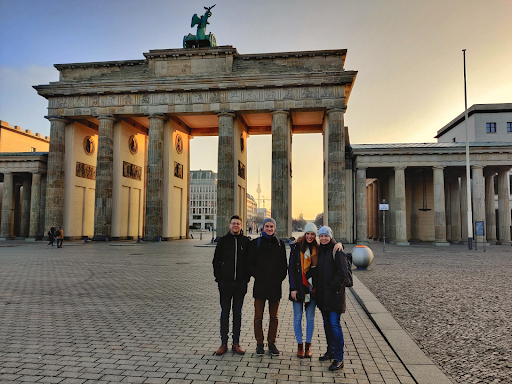Blog posts are written by project team members. Topics range from conferences we attend, musings on current affairs of relevance, internal project findings and news and more succinct content which can be found in our Digital Humanities Case studies or project related publications. Blog posts will mainly be posted in English but will from time to time feature in the language of the project team member’s preference, since we are a multilingual bunch! Happy reading!
Digitization and Digital Humanities: The Role of the University of Innsbruck in the NewsEye Project
The University of Innsbruck joined the NewsEye Project with researchers from two different institutions: The Digitisation and Digital Preservation Group and the Department of Contemporary History. In this post we reflect on the project experiences of researchers from both departments.

(From right to left) Eva Pfanzelter, Sarah Oberbichler, Benedikt Kapferer and Stefan Hechl from the Department of Contemporary History. The picture was taken during a meeting in Berlin, which brought computer scientists and historians together to work on joint research questions and dissemination. The meeting took place in February 2020, just before the Covid pandemic forced us to subsequently only meet online.
At the University of Innsbruck, NewsEye brought together researchers that share an interest in improving access to digitized historical newspapers. The Digitisation and Digital Preservation Group, led by Günter Mühlberger, played a key role in data management and in providing a single access point for all tasks connected with the management of research data. The digital humanities group, led by Eva Pfanzelter, on the other hand, was interested in answering new research questions based on improved data and new methods provided throughout the project.
The videos below (in German with English subtitles and in Italian) demonstrate the level of expertise held by various members of the NewsEye team:
Finding solutions for this challenge was essential in order to bring together different research perspectives and interests within the project. While historians learned to find their ways in balancing research demands and (technical) possibilities, the project's computer science and digitization teams needed to find an understanding for historical workflows. Those experiences and the reflections on shared workflows found place in one of our research papers: Integrated interdisciplinary workflows for research on historical newspapers: Perspectives from humanities scholars, computer scientists, and librarians.
One of the most important outcomes from the perspective of the DEA team was the chance to create a multi-lingual, multi-font OCR model for the Transkribus platform. Based on Austrian, Finnish, Swedish and French newspapers from several periods and with a high variability of fonts the model achieves excellent results for any kind of printed text in the above mentioned languages. The data set was published at the ZENODO platform and downloaded more than 200 times. It also formed the basis for an even larger dataset which was set up within the Transkribus platform and which was completed with Dutch, German, Danish, Spanish printed documents and newspapers. The model is publicly available via the Transkribus platform.
For the historians at the University of Innsbruck, the improved data sets as available on the project's platform opened worlds of doing research with historical newspapers. It soon became clear that concerns about the impact of poor quality of the digitized newspapers were not dominating research workflows. And even though the limited access to improved data has complicated our work from time to time, experiments on smaller datasets have led to great results and hopefully future leading examples. Some of those reflections and results have been published in the following papers:
Creativity and the will for understanding each other's workflows have been essential for the project's success. The Covid pandemic has made it impossible for us to meet and collaborate in person, however, all project partners have found creative solutions to deal with those issues. Research on digital newspapers has definitely benefited from the common efforts and collaboration in Innsbruck and beyond will continue.
The team members at the University of Innsbruck included following people:
- Eva Pfanzelter, Deputy Head of the Department of Contemporary History, was leading the Digital Humanities group within the NewsEye project. With her, Sarah Oberbichler, Barbara Klaus, Stefan Hechl and Benedikt Kapferer were working on digital humanities applications and uses.
- Günter Mühlberger, head of the Digitisation and Digital Preservation Group, led the data management within the project. With him, Mirjam El Attal, Günter Hackl, Daphné Pelat, Florian Guggenberger, Marja-Leena Hynynen.